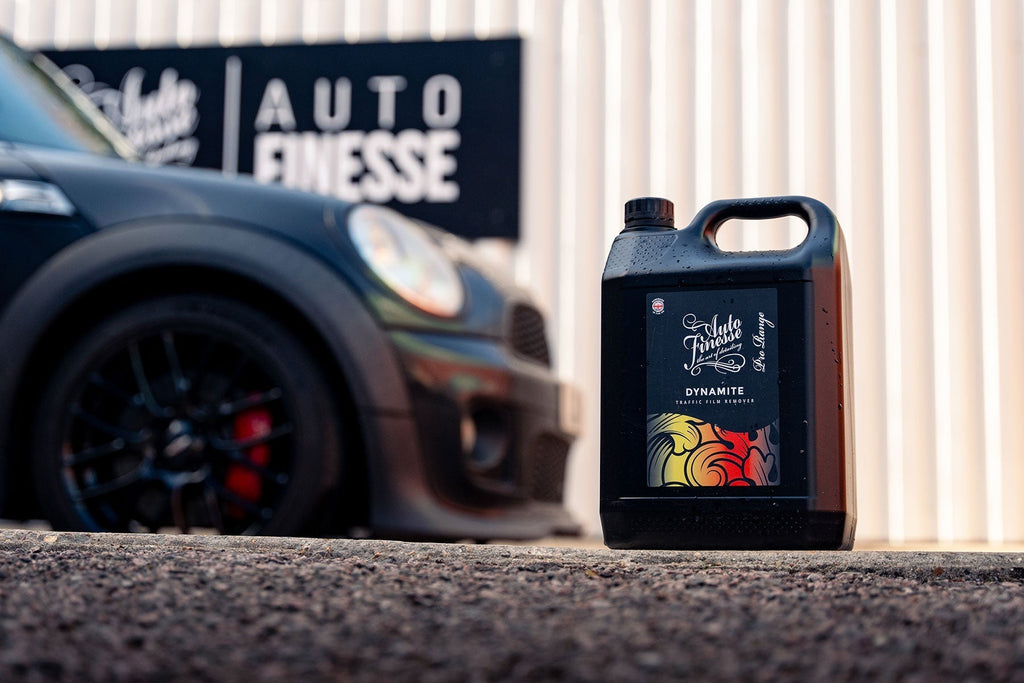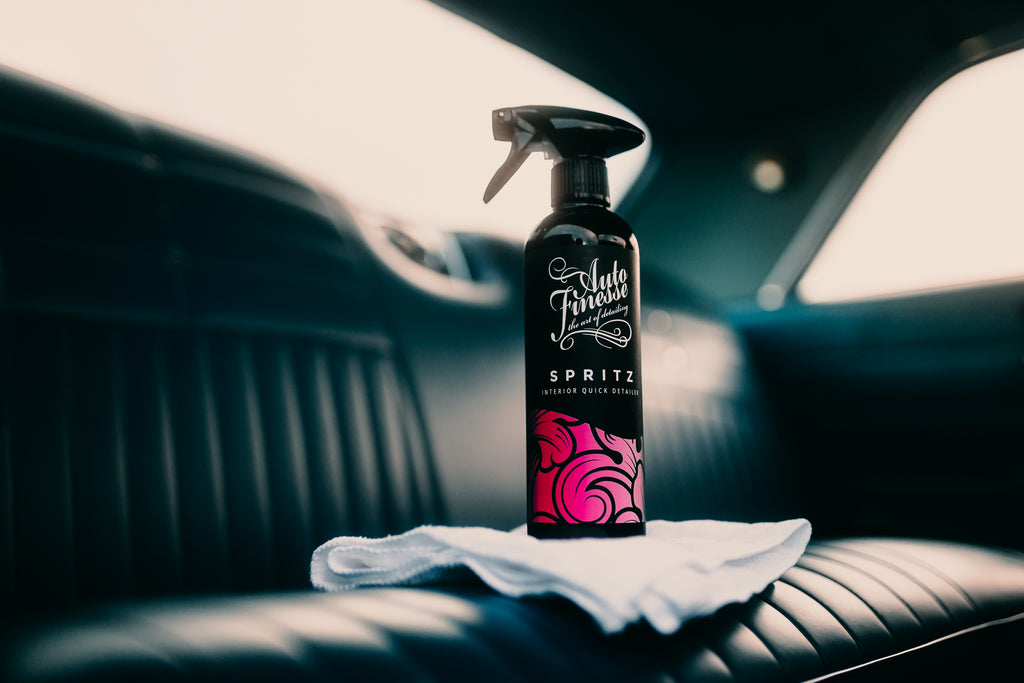Le guide ultime des tampons de polissage

IN THIS GUIDE:
- See the difference between all types hand and machine polishing pads and what they're made off.
- Discover which type of polishing pad is best for each part of the paint correction process.
- See what pad to use with each type of polishing product to get the best results every time.
You can't achieve the best results from your car's paintwork without polishing, and you can't polish effectively without the right pad. It’s not some car detailing myth—it’s simply how it works. When it comes to detailing, using the best detailing products and accessories is essential for getting the job done right.
But here’s the most important question: How do you choose the right polishing pad for different levels of correction and refinement, all while avoiding costly mistakes? That's exactly where we come in. In this section, we’ll break down everything you need to know about the various types of polishing pads and how to use them to achieve optimal results. Whether you’re tackling light swirl marks or heavy imperfections, we’ve got you covered!

What Exactly Is A Polishing Pad?
When we talk about polishing pads, we're primarily referring to machine polishing pads, with foam pads being the most commonly used for paint correction and refinement. However, pads can also include foam and microfibre varieties, as well as applicators designed for hand polishing, glazing, and spot defect removal. Some pads—like our Revitalise Spot Pads—are versatile enough to be used for both hand and machine polishing.
For this discussion, we'll focus on choosing the right machine polishing pads for your specific needs. But remember, hand polishing pads and applicators, typically made from the same materials, function in the same way—just at a slower pace.
While there are many different types of polishing pads out there, they can generally be grouped into categories based on size and material. In the detailing world, there are three main types: foam, microfibre, and wool.
Microfibre and wool pads are more aggressive and are primarily used for heavy cutting and spot defect removal. Foam pads, on the other hand, come in various types, each designed to handle everything from cutting to refining and finishing. When it comes to size and fit, most modern pads use a hook and loop (Velcro) system that allows them to attach securely to the backing plate of your machine polisher. The most common sizes are 5-inch, 3-inch, and 1-inch, which are designed to fit the most popular machine polishers. However, other sizes are available depending on your needs.
There are also foam pads that screw directly onto a rotary polisher. These are typically used by refinishers in body shops for tasks like making freshly sprayed panels flat and free of orange peel. While these types of pads are great for mopping or heavy-duty cutting, they are not generally used for the fine paint refinement that we aim for in detailing.

How Do Pads Polish Vehicle Surfaces?
The first thing to understand about polishing pads is that, in a sense, they function like an abrasive—similar to sandpaper, but much finer. When used with abrasive products like polishes or compounds, the pads hold and work these products across the surface, helping to break them down and correct or refine the paintwork in the process. But what's just as crucial as the product you use on the pad is the performance of the pad itself. This combination of product and pad makes up what we call the detailer's 'combo', and it plays a huge role in how the paint is affected.
Changing the pad while using the same polishing product can slightly alter the outcome. Different pads can help you account for various paint types and levels of defect, allowing you to tailor your approach for optimal results.
Polishing pads work through friction, and the level of friction generated by a pad directly correlates to how much of the paint’s surface it will affect during the cutting or refining process. The more friction, the more material is removed from the paint, whether you're cutting to remove defects or refining to smooth and perfect the finish. The right balance of friction and pressure is key to achieving the desired result without damaging the paint.

What Are Polishing Pads Made Of?
The materials used to make a machine polishing pad are crucial in determining how well it performs. Each material has its own unique properties that influence the pad's ability to correct, refine, and finish the surface.
Each material impacts how the pad interacts with both the polishing product and the surface you're working on. The choice of material, combined with the correct product and technique, directly affects the overall performance of the pad, whether you're aiming for heavy cutting, light correction, or a flawless finish.

Microfibre and Wool Polishing Pads
Microfibre and wool pads are technically non-abrasive, but when used with the right compound or polish, they become incredibly aggressive. These pads give the abrasive product more "bite" because the natural or synthetic fibres have a much larger surface area compared to foam pads. This increased surface area results in more physical contact with the paint, creating greater friction. In simple terms, this friction generates more heat, which allows the pad to cut through the paint or clear coat more quickly and aggressively.
Wool pads are the most aggressive, designed primarily for use on rotary polishers. They can cut through the heaviest defects with ease, but the result is always a surface that requires additional refinement. The wool pad tends to leave behind abrasions and holograms which means you'll need to follow up with a less aggressive pad..
Microfibre pads are slightly less aggressive than wool, but they still pack a punch. They can remove heavier defects, but they often leave behind tiny micro-scratches or a cloudy finish that needs further refining. However, microfibre pads are great for use with dual action polishers, which can make them a slightly safer option compared to wool pads, especially for those less experienced with rotary machines.
While wool and microfibre pads are commonly used for heavy defect removal, they are typically reserved for cases where a foam pad isn’t enough—such as on multi-stage corrections or when working with vehicles that have significant paint damage or fresh paint that hasn’t been fully flatted and polished. For most vehicles with medium to light defects, foam pads are the go-to option for cutting, as they are less aggressive and safer for most paint types.
For finishing, glazing, and polishing tasks, softer foam pads are always preferred. They provide the delicate touch needed to refine the paint, eliminate light imperfections, and achieve that perfect, glossy finish.







Engineered specifically to increase the bite of abrasive compounds and polishes, Microfibre Spot Pads are the quick and easy way to transform your Handi Puck i... See product details More
Foam Pads
For obvious reasons, foam pads are the most popular choice in detailing. Their versatility and availability in various levels of cut make them suitable for all stages of the paint refinement process, from heavy defect removal to achieving a flawless finish.
The aggressiveness of a foam pad is determined by its construction, which is specifically designed for the particular part of the correction process it’s meant to handle. Foam pads can range from extreme cutting—typically used in body shops for flatting and heavy defect removal—to more refined cutting, polishing, and finishing for the detailer's final paint enhancement stages. This versatility is achieved through the density and structure of the foam, as well as how the foam interacts with the surface and retains heat during use.
Harder, denser foam is used for cutting because it provides more abrasion, surface contact, and increased heat retention, which helps to break down defects in the paint more effectively. Lighter, less dense foam pads, on the other hand, are ideal for paint refinement and finishing. They are less aggressive and create less friction, making them perfect for removing finer imperfections and achieving that glossy, smooth finish.
It's important to remember that, technically, all polishing processes are still cutting—but as you move from cutting to refining and finishing, you're simply cutting at a finer, less aggressive level. The process of multi-stage polishing involves correcting the heaviest defects first, then progressively tackling the smaller imperfections left behind by each stage.
In simple terms, the more aggressive the pad, the deeper the defects it will remove. However, this also means it will leave behind larger imperfections that will need to be corrected in subsequent stages. Over time, by refining the paint with progressively less aggressive pads and products, the defects become smaller and less noticeable until they are completely eliminated, leaving the paintwork flawless and mirror-like.


Open Cell vs Closed Cell Foam
A commonly asked question about foam pads is what makes up the foam itself. Essentially, foam is composed of thousands of microscopic cells packed together in a non-uniform mass. Each of these cells has a skeletal structure and an outer membrane or skin, which forms the walls of the cell. All these cells are bound together, giving the foam its body. Imagine foam as like a collection of steel-framed buildings clustered together. There are two types of foam commonly used in detailing - closed and open cell.
In this closed cell foam, the cell membranes remain intact, meaning the individual cells are sealed off. This structure gives the foam its dense, compact nature. When the foam is manufactured with these sealed cells, it prevents liquids and air from easily passing through the material. This means that when a closed cell foam pad is used, compounds (along with any spent product and removed paint) tend to remain on the surface and migrate toward the middle of the pad as it spins. Airflow through the foam is very restricted, so closed cell pads heat up quickly and retain that heat for a long time. For these reasons, closed cell pads are typically used in heavy cutting stages, particularly with rotary polishers. They are highly effective at removing heavy defects but are harder to clean and tend to build up heat faster. Closed cell pads are often referred to as cutting pads due to their high level of aggressiveness.
Open cell foam - the kid of foam we use in all of our polishing pads - is made by removing the cell membranes through a process called reticulation (essentially exploding the cells), leaving behind the skeleton of the foam structure. As a result, open cell foam has a much more porous, 3D honeycomb structure, making it different in both appearance and function. The porosity of open cell foam helps it soak in the polishing product, allowing it to collect and store spent compound and removed paint particles deep within the foam. This structure also allows for better airflow, which means open cell foam pads are more efficient at dispersing heat. This makes them safer to use, particularly with a dual-action polisher, as the increased airflow prevents overheating and allows for longer use without the risk of damaging the paint.
Open cell foam pads can also be manufactured in a variety of densities and firmness levels. Softer versions are perfect for fine refinement, polishing, and finishing tasks, while higher-density open cell pads can still achieve a significant level of cut—similar to that of closed cell foam pads—while offering better heat dissipation and ease of cleaning.
So, while closed cell pads can be used for the most aggressive cutting and heavy defect removal, open cell pads offer versatility, safety, and efficiency, making them suitable for everything from cutting to fine finishing and glazing.

Pad Density
Density, whether in open or closed cell foam, refers to the stiffness of the foam, which directly impacts its performance. Stiffer foam is naturally more aggressive on painted surfaces, which is why denser pads are typically used for cutting. These pads provide more abrasion and surface contact, helping to remove defects faster. On the other hand, softer pads are ideal for refinement and finishing because they are gentler on the paint, providing a smoother finish with less removal of part of the surface.
However, what's often overlooked is that the density of the foam actually changes as you work. As a pad becomes saturated with polishing products and heats up during use, the foam loses some of its original density. In practical terms, this means that the pad will become less aggressive as you continue working. The cutting performance will diminish as the foam softens, which is why a new, dry pad will perform better than a pad that has been used on multiple panels or for an extended period.
This is one of the key reasons why we recommend regularly cleaning the pads between polishing sets. By doing so, you can help maintain the pad's effectiveness and ensure it continues to perform optimally throughout the detail.
Another consideration is how many pads you should use during the entire detailing process. While it might not always be practical, the most efficient cut comes from using a fresh pad for each panel or area. The more pads you use, the faster you can complete the job, because each pad will maintain its cutting power for a longer period. Switching pads between panels helps ensure that you’re always working with a pad at its peak performance, leading to faster, more consistent results.

Tensile Strength And Elasticity
The tensile strength of a foam pad, more accurately referred to as elasticity, is another important factor that influences its performance. Elasticity refers to the foam’s ability to stretch or bend without breaking, and it plays a key role in the pad's durability and flexibility during use. When it comes to machine polishing, this is particularly important for working on contoured or curved panels, as the pad needs to maintain its integrity while conforming to the surface.
Open cell foam pads tend to have higher tensile strength and are more pliable than closed cell foam pads. The open structure of the foam allows it to be more flexible, which means it can bend and stretch more easily around curves and contours without tearing or losing its shape. This makes them ideal for polishing areas with complex curves, such as door panels, bumpers, or wheel arches.
Closed cell foam pads, on the other hand, are generally stiffer and less flexible, meaning they may not conform as easily to complex surfaces. While they are still durable, they are more prone to losing shape if subjected to too much pressure or if used on surfaces with sharp curves.
In practical terms, the elasticity of the foam pad affects its ability to follow the contours of the vehicle, helping the pad to remain in consistent contact with the paint and deliver a more uniform finish. When working on flat surfaces, this may not be as critical, but when tackling complex or curved panels, a more pliable, open-cell pad is often preferred because it can maintain full surface contact without causing damage to the paint or the pad itself.

Cleaning Polishing Pads
Regular pad cleaning during use is essential to maintaining optimal performance, preventing clogging, and stopping your pad from becoming completely saturated with spent product. To clean your pad during use, simply hold a Pad Cleaning Brush against the pad (make sure to do this away from the vehicle to avoid cross-contamination) and run the machine at a low speed. This will help scrub out the excess product and contaminants that accumulate during polishing, ensuring the pad continues to work efficiently. Regular cleaning also prevents the pad from becoming over-saturated, which can affect its cutting ability and lead to uneven or inefficient polishing.
After completing a full detail, deep cleaning your pads is just as important to ensure they’re ready for the next job. This process involves thoroughly removing all leftover product, oils, and residues that could impact the pad’s performance in future uses. Wet cleaning your pads between details is easy and can be done using a stiff Pad Cleaning Brush along with Verso All Purpose Cleaner. The combination of these tools helps break down the residues left behind in the foam, restoring the pad to its optimal state. Gently rinse the pad to remove any loose debris, then scrub it with the cleaner and brush to lift out any stubborn product and contaminants. For particularly dirty pads, soaking them in a bucket of water and cleaner can help loosen and dissolve any lingering residues.
When it comes to microfibre machine polishing pads, you can clean and recondition them just like your microfibre cloths. Use Micro Wash Microfibre Detergent to wash your microfibre pads. This specially formulated detergent is designed to remove oils and product residues without damaging the fibres, ensuring your pads stay in top shape. Following the cleaning instructions from our guide: Selecting The Right Microfibre Towel for the Job, will ensure that your microfibre pads are properly cared for and ready for future use.
Thoroughly cleaning your pads not only helps maintain their performance but also increases their longevity. By keeping your pads free from built-up residues, you ensure they stay effective and efficient, helping you achieve better results with every detail. Furthermore, regular cleaning prevents cross-contamination between products, which could affect the outcome of your next job. In short, maintaining your pads through consistent cleaning—both during and after each detail—is key to achieving the best results and making your pads last longer.







A small but essential tool to aid in every machine polishing process, our Pad Cleaning Brush is designed for the quick, simple and safe removal of compound res... See product details More
CHECK OUT OUR FULL RANGE OF PROFESSIONAL-GRADE POLISHING PADS
Revitalise Machine Polishing Pads
Our 5-inch Revitalise Pads have been specifically designed for use with our DPX Machine Polisher and MPX Dual Action Machine Polisher. These pads are the cornerstone of our machine polishing range, created to handle every stage of the paint correction process with ease. What makes them even more user-friendly is their colour-coding, which corresponds directly with our Revitalise System Compounds, allowing you to quickly and easily select the right pad and product combination for the job.
All three pads in the Revitalise range are constructed from reticulated open-cell foam, which provides excellent durability and performance while ensuring optimal product application and consistent results throughout the correction process. Whether you're tackling heavy cutting or refining a flawless finish, these pads are versatile and built to handle all aspects of paint correction with precision.








Developed as the ultimate foam polishing pads for the use with any 5-inch machine polisher, Revitalise Pads are slightly oversized and feature rounded bumper ed... See product details More
Pro Series Machine Polishing Pads
Our Pro Series Polishing Pads are the result of over three years of intensive research and development, created specifically for trade professionals and experienced detailers who demand the best results in the shortest time possible. These pads are meticulously designed to complement our Pro Series Compounds, ensuring the ideal pairing for each of the three compound grades, making them a perfect choice for those seeking optimal efficiency and performance.
Constructed from advanced open-cell foam, the 5-inch Pro Series pads offer the highest levels of elasticity and tensile strength, ensuring durability and exceptional performance. With these pads, detailers can expect consistent cutting power, smoother application, and longer-lasting results, even under heavy use. Whether you're refining surfaces or tackling heavy paint correction, these pads are engineered to deliver professional-grade results with speed and precision.
Supplied in packs of two, our Professional Series Pads are available as No.36 Heavy Cutting Pads (purple), No.23 Medium Polishing Pads (teal) and No.15 Fine Finishing Pads (grey).

Revitalise Spot Pads
Our Revitalise Spot Pads are the compact, 80mm version of our regular Revitalise Pads, designed for precision work and available in the same advanced open-cell foam construction. Like their larger counterparts, they are colour-coded to seamlessly pair with our Revitalise Compounds, making it easy to select the right combination for the task at hand.
These pads are perfect for use with 3-inch machines, such as our MPX Dual Action Machine Polisher, allowing for efficient multi- or single-stage correction of smaller vehicle areas or spot defect removal. They are also an excellent choice for hand polishing when paired with our ergonomic Handi Puck, which provides a comfortable and secure grip for more precise control during polishing. Whether you're tackling tight spots or intricate areas, the Revitalise Spot Pads deliver the precision and flexibility needed for flawless results.

Microfibre Spot Pads
The Microfibre Spot Pad is another excellent option for use with the Handi Puck or our MPX Machine Polisher. Crafted to enhance the effectiveness of any polish or compound, it delivers exceptional performance for spot defect removal. While compact in size, its large surface area enables you to achieve impressive results with ease.







Engineered specifically to increase the bite of abrasive compounds and polishes, Microfibre Spot Pads are the quick and easy way to transform your Handi Puck i... See product details More
Pro Pucks
Our Pro Series Polishing Pucks are constructed from the same advanced foam used in our 5-inch Professional Series Polishing Pads, and they are designed to simplify and enhance the hand polishing process. These pucks are particularly useful for tackling tight or difficult areas where a large machine polisher would be too bulky, or a compact machine polisher isn't available.
The 100mm colour-coded open-cell foam pads come with a heavy-duty ergonomic grip, ensuring consistent and even results. The Pro Series Polishing Pucks are available in packs of two, in three variations: No.36 Heavy Cutting Pucks (purple), No. 23 Medium Polishing Pucks (teal) and No.15 Fine Finishing Pucks (grey). Ideal for both machine and hand polishing, these pucks make achieving professional-grade results easier than ever.

Microfibre Polish Pads & Applicators
For professional-level hand polishing, we offer a range of premium Microfibre Polish Pads and Microfibre Applicators to meet your needs. Our Polish Pads feature soft, short-pile microfibre wrapped around a foam core, which is designed to mold perfectly to any contour for a smooth and even finish. The dual-sided Microfibre Applicators, on the other hand, are a double-sided detailer's essential, crafted from high-quality short-pile microfibre for durability and performance.
Both products are ideal not only for hand polishing but also for applying finishing and protection products, such as Ultra Glaze Paint Glaze or Revive Trim Dressing, ensuring flawless application every time.

And there you have it – everything you need to know about hand and machine polishing pads, along with a few applicators to round out your comprehensive detailing kit.
For more expert product guides and pro tips, be sure to explore the Guides Section Of Our Blog.

































